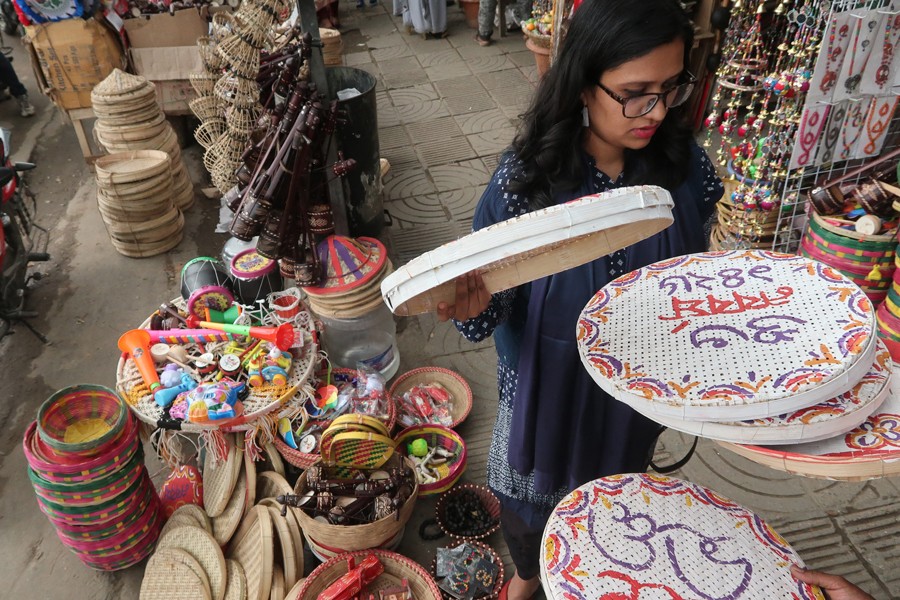
Published :
Updated :

The craze for panta-elish (soaked rice and fried Hilsha) among the urbanites has subsided to some extent but not vanished altogether. There are still people who think without Hilsha, the celebration of the Pahela Baishakh loses all its lustre. Sure enough, this is a late addition. Even the celebration of the Bangla New Year remained a muted event in most cities and towns until the Chhayanaut’s Midas touch to the occasion in the early 60’s.
In fact, introduction of Hilsha with panta has eroded the aesthetic beauty and the quiet culture of a celebration. There was at no point in the celebration of the Bangalee’s New Year any type of flaunting; rather there was an expression of the peaceful and refined cultural yearning of the soul. Thanksgiving for the bounteous or even the meagre allowances Nature and the Almighty have bestowed on the people.
In our childhood, never had we known that panta was a delicacy. Instead, there was a long preparation for observance of the Sangkranti, the last day of the year. It was the time when all households –irrespective of their financial standings or social status –heartily welcomed their newly married daughters and sons-in-law. Visiting the bride’s home was a must. So every family had to stock muri, khoi and chira (fried, puffed and beaten rice) in their cellars well ahead of the Sangkanti. On that day and the next day –the Pahela Baishakh that is – the breakfast consisted of those three rice items along with curd (often homemade), an array of unadulterated sweetmeat and pithas (indigenous cakes). Such were the treats on the two consecutive mornings.
On the Sangkranti, there was no arrangement for any sumptuous dishes. Just leaves of a few bitter medicinal plants along with figs, the soft inside of cane twigs etcetera made for a mixed curry and then there were pulse prepared with green mango slices and smoked with mustard seeds. Of course yoghurt or curd and sweetmeat were served as a dessert. But traders who closed their yearly accounts invited their customers on the occasion of Halkhata, meaning updating the account. The customers were treated with sweetmeat.
But the lunch of the Pahela Baishakh was a real treat when everyone tried to have sumptuous dishes. Unless extraordinary wealthy, no one could think of meat items. The main attraction was to have a big fish –as big as possible –for the midday meal. The poor could not afford such fish but since there were natural water bodies for fishing, most of the time they collectively gathered as if in a fishing festival to catch fish in a particularly fish reserve. The lucky one could get hold of a few big fish but those who were not equally fortunate also could manage fish unavailable nowadays. Also the best catchers were generous enough to share their prized catches with the unlucky ones. Thus the social camaraderie was never found wanting among the communities.
What were the roles of children in the celebration? Actually, in our childhood we eagerly looked forward to the village fair that was arranged for the two august days. Yes, the Sangkranti and the Pahela Baishakh to us came as a gift from the heaven. When we were mere child, we yearned for clay dolls, flutes made of both tin and bamboo. Balloons, dholok (small musical drums) and kites were the other most sought-after items in that tender age. It was the time of unalloyed innocence, it was the time of simple joy. We never yearned for something extraordinary, excess or outrageous.
If all the knick-knacks with no practical value we considered our prized possession, there was, however, one most valuable item without which our childhood proved simply meaningless. Have any guess? Perhaps not. It is a knife either made by the local blacksmith or a fashionable one imported from a foreign land. Most of the time we could not afford to buy an imported knife. Now why were the knives so essential? It was because without those green mangoes could not be peeled off and sliced. Those who have not thrown stones at green mangoes hanging from branches and enjoyed those right under the trees will not know the joys and excitement of childhood.
In cities, children are captive to their parents’ care and they are deprived of the simple delights and carefree mental flights of the best of time in human life. Time children were given a chance to celebrate the Pahela Baishakh in their own special way.


 For all latest news, follow The Financial Express Google News channel.
For all latest news, follow The Financial Express Google News channel.